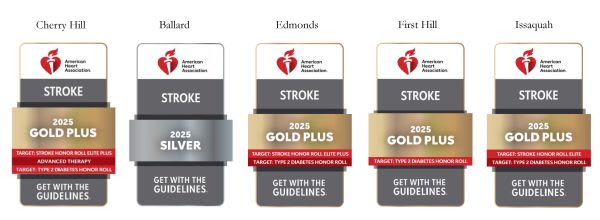Wearable and personal heart monitors are increasingly popular
[6 min read]
In this article:
- There are several types of monitors available, and they can be useful for keeping an eye on your overall health.
- Wearable heart monitors are becoming popular for detecting and managing a cardiovascular condition called atrial fibrillation, or Afib.
- A Swedish cardiovascular expert explains the benefits and limitations of these devices and why it's vital to speak with your doctor if you are considering using one.
Atrial fibrillation (AFib) is a common heart rhythm disorder that affects millions of people worldwide. It is characterized by an irregular and often rapid heartbeat, which can lead to numerous complications including blood clots, stroke, heart failure, and other heart-related complications. Risk factors include sleep apnea, being overweight, excessive alcohol consumption, hypertension and having diabetes – to name a few. Yet, this condition is rarely fatal.
To learn more, we spoke with Iulia Tulai, M.D., cardiologist at Swedish who specializes in cardiovascular disease and has a special interest in patients with atrial fibrillation. Dr. Tulai notes that symptoms can vary widely, from essentially asymptomatic to severe symptoms. Young, otherwise healthy patients can even mistake atrial fibrillation for an anxiety attack, she says.
“While there are several classifications [of Afib] that we could talk about, the most common classification used is based on timing. There is paroxysmal Afib, in which Afib episodes last for less than seven days, there is persistent Afib – when it lasts more than 7 days, longstanding persistent – usually more than a year, and permanent – when decision has been made to not pursue normal heart rhythm anymore. Recently we also added the notion of “Silent Afib” - when it’s diagnosed almost by accident, if you will, such as via medical or non-medical devices worn for a different reason” says Dr. Tulai. “There is also a very wide range of symptoms: from completely asymptomatic to severely symptomatic, even causing issues such as severe heart failure, with the patient being admitted in the hospital, possibly even in ICU.”
“I compare it to an on-off light-switch button: the light is either on or off, and it can be flipped between the two states multiple times. The same way, your heart is either with the light on, you are in atrial fibrillation or out of it – with the light off. And the same as with a light switch, it can easily turn on and back off multiple times. Basically, the heart can flip between a normal heart rhythm (called sinus rhythm) and an abnormal one, in this case atrial fibrillation. In normal sinus rhythm the usual heart rate is somewhere between 60 to 100 beats per minute, and it also beats regularly.”
When the heart flips into Afib, two things usually happen at the same time: first, the heart rate suddenly increases to a fast rate, usually 120 beats per minute or more, sometimes close to 180. Second, the heart starts beating very irregularly,” says Dr. Tulai. “The combination of a fast heart rate and an irregular heartbeat can understandably be very unpleasant for a patient.”
“These devices are great as fitness devices. But, if you intend to purchase one for a medical reason, I cannot stress enough that you should talk to your physician first, since their usefulness and applicability in medical conditions remains a very individualized decision between you and your physician.”
With advancements in technology, wearable heart monitors have become increasingly popular for detecting and managing AFib. While this convenient, new technology can be useful in keeping an eye on your heart and overall health, it’s important to understand what wearable/personal heart monitors can and cannot do.
“In terms of their overall usefulness for the general population, the jury will be out on this for a while,” says Dr. Tulai, noting that there is considerable ongoing research around the technology. “These devices can certainly be useful for the right patients, but they can also be detrimental in others, so it really depends on the person we are using these for.”
Types of wearable/personal heart monitors
- Wrist-based, chest strap and patch based. These monitors are perhaps the most common type of wearable heart monitors. Most of them use a technology called photoplethysmography (PPG), which is an optical technique that can evaluate and analyze blood wave forms and is used to assess oxygen saturation and heart rate amongst other parameters. They use photosensors to detect irregularities in heart rhythm and provide users with real-time updates on their heart rate. They are easy to wear, unobtrusive, and user-friendly. However, their accuracy can be affected by wrist movements and sometimes can result in false readings. Their efficacy can be affected by hydration level, how tight or loose it is on the wrist, by skin tone and type of movement. They may also require additional hardware or software integration to access and analyze the collected data.
- Handheld. Electrode-based technology (EBT) relies on analyzing the heart’s electrical activity. These consumer EBT devices are like mobile cardiac monitors, yet most of them are not considered medical devices.
“There are certain touch points with these devices. You put your fingers on them, sometimes even your leg, and they are able to analyze the electrical triangle created between the device and your touch points,” says Dr. Tulai. “It creates an EKG reading that’s more reliable.”
Which one is best?
“So, it goes back to the question of what you’re looking for,” says Dr. Tulai. “For example, if a patient has palpitations, these can be a result of an abnormal heart rate – meaning the heart is just going too fast but the actual rhythm is normal. Or, palpitations can be a result of an abnormal heart rhythm, such as Afib. If it is an abnormal heart rhythm that we are trying to detect, then we might benefit more from an EBT device, as this can analyze the electrical activity of the heart. PPG based devices might also have a role in this, but they tend to inform us more about the heart rate and possibly its regularity, rather than inform us about the actual heart rhythm. When indicated, patients can even obtain a home EKG with these EBT devices and even send the recording to me for review.”
These devices are valuable tools that complement regular medical care and provide additional insights into a patient's heart rhythm,” notes Dr. Tulai.
“They enable individuals to track their heart health continuously, allowing for more proactive management and sometimes even prevention of AFib-related complications,” she says. “But I never recommend these devices as a screening tool or in place of professional care. There can be a lot of false information that can be disturbing or, on the contrary, even falsely reassuring.”
“These devices are great as fitness devices. But, if you intend to purchase one for a medical reason, I cannot stress enough that you should talk to your physician first, since their usefulness and applicability in medical conditions remains a very individualized decision between you and your physician.”
Learn more and find a practitioner
Providence Swedish is home to the only comprehensive AFib clinic in the Puget Sound region. Learn more at our website or call 206-215-4545 to make an appointment.
The team of specialists at the Swedish Heart & Vascular Institute has access to the latest treatments and technology and the expertise to know how to use it safely and effectively. Call 206-320-4100 to learn more about the vascular care we offer.
Whether you require an in-person visit or want to consult a doctor virtually, you have options. Contact Swedish Primary Care to schedule an appointment with a primary care provider. You can also connect virtually with your provider to review your symptoms, provide instruction and follow up as needed. And with Swedish ExpressCare Virtual you can receive treatment in minutes for common conditions such as colds, flu, urinary tract infections and more. You can use our provider directory to find a specialist or primary care physician near you.
Information for patients and visitors
Related resources
Are you at risk for heart disease? Take this short quiz to learn more.
Heart health advice for every age
Understanding deep vein thrombosis
Patient goes the distance for TAVR
This information is not intended as a substitute for professional medical care. Always follow your health care professional’s instructions.




